Related Research Articles
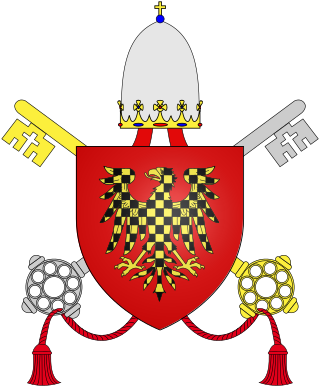
Pope Alexander IV was head of the Catholic Church and ruler of the Papal States from 12 December 1254 to his death in 1261.

Pope Gregory IX was head of the Catholic Church and ruler of the Papal States from 19 March 1227 until his death in 1241. He is known for issuing the Decretales and instituting the Papal Inquisition, in response to the failures of the episcopal inquisitions established during the time of Pope Lucius III, by means of the papal bull Ad abolendam, issued in 1184.

Pope Innocent III, born Lotario dei Conti di Segni, was the head of the Catholic Church and ruler of the Papal States from 8 January 1198 until his death on 16 July 1216.

Pope Innocent XIII, born as Michelangelo dei Conti, was head of the Catholic Church and ruler of the Papal States from 8 May 1721 to his death in March 1724. He is the most recent pope to date to take the pontifical name of "Innocent" upon his election.
Conti is an Italian surname.

The Camerlengo of the Holy Roman Church is an office of the papal household that administers the property and revenues of the Holy See. Formerly, his responsibilities included the fiscal administration of the Patrimony of Saint Peter. As regulated in the apostolic constitution Pastor bonus of 1988, the Camerlengo is always a cardinal, though this was not the case prior to the 15th century. His heraldic arms are ornamented with two keys – one gold, one silver – in saltire, surmounted by an ombrellino, a canopy or umbrella of alternating red and yellow stripes. These also form part of the coat of arms of the Holy See during a papal interregnum. The Camerlengo has been Kevin Farrell since his appointment by Pope Francis on 14 February 2019. The Vice Camerlengo has been Archbishop Ilson de Jesus Montanari since 1 May 2020.
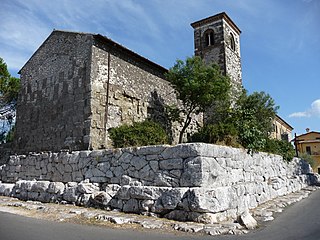
Segni is an Italian town and comune located in Lazio. The city is situated on a hilltop in the Lepini Mountains, and overlooks the valley of the Sacco River.
Papal coats of arms are the personal coat of arms of popes of the Catholic Church. These have been a tradition since the Late Middle Ages, and has displayed his own, initially that of his family, and thus not unique to himself alone, but in some cases composed by him with symbols referring to his past or his aspirations. This personal coat of arms coexists with that of the Holy See.
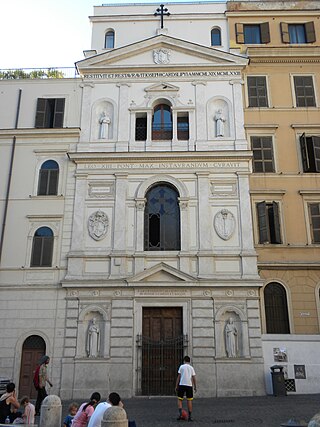
Santi Sergio e Bacco is a Catholic church of the Byzantine Rite located on Piazza Madonna dei Monti in the rione of Monti in Rome, Italy. Saints Sergius and Bacchus are said to have been early fourth-century Roman military officers and Christian martyrs buried in Syria. In the 9th century the church was known as Sergius and Bacchus in Callinico, in the Middle Ages as Sergius and Bacchus de Suburra, and from the 18th century forward has been known also as the church of Madonna del Pascolo. Since 1970 it has been a national church of the Ukrainian Greek Catholic Church in Rome and was known officially as the "Parish of Ukrainian Catholics of Madonna del Pascolo and Saints Sergius and Bacchus." Since 2019 the church serves as a cathedral for the Ukrainian Catholic Apostolic Exarchate of Italy.

The Diocese of Anagni-Alatri is a Latin Church ecclesiastical territory or diocese of the Catholic Church in Lazio, Italy. It has existed in its current form since 1986. In that year the Diocese of Alatri was united to the historical Diocese of Anagni. The diocese is immediately exempt to the Holy See.

The 1227 papal election, was convoked after the death of Pope Honorius III on 18 March 1227 at Rome.

The 1198 papal election was convoked after the death of Pope Celestine III; it ended with the election of Cardinal Lotario dei Conti di Segni, who took the name Innocent III. In this election for the first time the new pope was elected per scrutinium.

Perugia was a long-time papal residence during the 13th century. Five popes were elected here: Pope Honorius III (1216–1227), Pope Clement IV (1265–1268), Pope Honorius IV (1285–1287), Pope Celestine V (1294), and Pope Clement V (1305–1314). These elections took place in the Palazzo delle Canoniche adjoining the Perugia Cathedral.
Cardinal Conti may refer to:
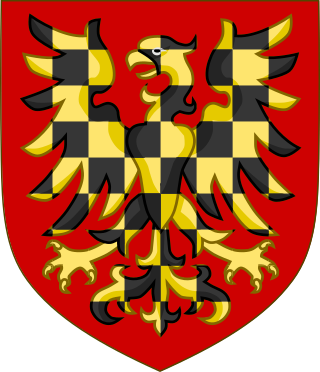
The counts of Segni were an important noble family of medieval and early modern Italy originating in Segni, Lazio. Many members of the family acted as military commanders or ecclesiastical dignitaries, including many cardinals and four popes.
Andrea dei Conti was an Italian Roman Catholic priest and a professed member of the Order of Friars Minor who was also a member of the noble house of Conti di Segni. The priest was best known for his humble life of solitude in which he was subjected to demonic visions and attacks though his faith in God saw him emerge time and time again as the victor. He lived his life in a small grotto in the Apennines.

Pope Gregory IX created sixteen cardinals in five consistories that he held throughout his pontificate. This included three future successors in the first allocation in 1227.

Pope Innocent III created 41 cardinals in ten consistories that he conducted throughout his pontificate. This included - in his first allocation in late 1198 - a future successor.

The Palace of the Popes in Anagni, sometimes called the Boniface VIII Palace (Palazzo Bonifacio VIII), is a building in the ancient hill town of Anagni in central Italy, in the hills east-southeast of Rome. It is closely associated in history with Pope Boniface VIII, was later bought by his nephew Peter II Caetani, and now houses a museum named after the Pope. It is at present part of a property owned by the Cistercian Sisters of Charity and used in part as their motherhouse.
References
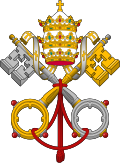
- ↑ "List of Popes," Catholic Encyclopedia (2009); retrieved 2011-11-3.
- ↑ "Pope Innocent III", Catholic Encyclopedia; retrieved 2011-11-6.
- ↑ "Pope Gregory IX", Catholic Encyclopedia; retrieved 2011-11-6.
- ↑ "Pope Alexander IV", Catholic Encyclopedia; retrieved 2011-11-6.
- ↑ "Pope Innocent XIII", Catholic Encyclopedia; retrieved 2011-11-6.
- ↑ "Victor IV", Catholic Encyclopedia; retrieved 2011-11-6.